IDEX Online Research: Inflation Creeping Up for Jewelry Industry
October 28, 09
There are signs that inflation is returning to the U.S. jewelry industry. Both key broad indicators – the Jewelry Consumer Price Index and the Jewelry Producer Price Index – spiked higher in September, and there are signs that inflationary pressures continued to build in October.
Inflation is usually driven by increasing demand in the face of potentially inadequate supplies. For example, most people speculate that diamond prices are headed higher over the long term because of the lack of visibility of new mine supplies in a market of growing global demand.
But demand isn’t driving jewelry prices higher.
This time it is a much more complex set of factors. For example, the price of gold has risen sharply in recent months. Since gold is a major component of jewelry, it is helping to push jewelry prices higher. There are at least four reasons for gold’s meteoric rise: 1) it is a safe harbor in an uncertain economy; 2) the U.S. dollar has been weak, and investors are selling dollars and buying gold; 3) when the global economy picks up, demand for gold and other precious metals will rise, and the current market anticipates this condition now; and, 4) gold has traditional been an inflation hedge. Many economists are predicting a wave of inflation as the market digests federal stimulus money from the U.S. government.
But the inflation puzzle doesn’t stop with gold. The U.S. dollar is losing value for several reasons. First, it is no longer the world’s sole reserve currency. Some countries are selling U.S. dollars and buying Euros as their reserve currency. Second, many investors fear that an inflationary U.S. economy will devalue the American dollar over the next year or two.
Because the American dollar is losing value against a basket of global currencies (but, interestingly, not so much against jewelry currencies), prices of foreign-produced goods and services are rising in line with the decline of the U.S. dollar. The most graphic example of this is the price of oil: as the dollar has been falling, the price of oil has been rising. Since oil is denominated in U.S. dollars on global markets, as the dollar falls in value, the price must rise to compensate for this decline.
In the jewelry industry, diamonds are denominated in U.S. dollars. Further, the key jewelry commodities – gold, silver and platinum – are denominated primarily in U.S. dollars, though those commodities are quoted in other currencies. The dollar seems to be the currency to which the values of these precious metals are pegged.
We view the inflation trends as temporary – certainly not more than a year or two. However, in the meantime, there will be increasing price pressure throughout the diamond and jewelry pipeline. What’s likely to cool inflation in America? It won’t be demand: Americans were born to spend. Rather, it will be a complex set of factors related to the global economy. For example, we believe that the European economies will be unable to pull themselves out of their current economic funk with rising production – they don’t produce much, demand is more stable than in growth economies, and the rising value of the Euro will dampen export demand. The only way – or certainly the most likely way – European economies will come out of the recession will be for the European Central Bank to “inflate” the currency. That will create a round of inflation in the future in Europe which will cause the Euro to fall against the American dollar. And the cycle will begin again.
Economists all seem to agree: some inflation is good. Too little and too much is bad. But no one really knows the range of “good” inflation, the U.S. Fed has tried to define it without much success.
In short, these inflation cycles are part of normal business cycles, and smart merchants will learn to deal with them.
Jewelry Industry Less Inflationary Than Other Economic Sectors
The table below provides a detailed summary of the factors that have some impact on jewelry price inflation. Here are some notes and observations:
- Jewelry prices at both the producer and consumer level rose sharply in September 2009.
- The U.S. dollar is weaker against all of the jewelry currencies except for the Indian Rupee and the Canadian dollar on a year-over-year basis. On a month-to-month basis, it is about flat against the Indian Rupee, and the U.S. dollar is down against all other primary jewelry currencies.
- All of the key precious metals used in jewelry manufacturing are up substantially. However, polished diamond prices remain depressed.
- All of the key measures of personal wealth – the global stock markets and U.S. home prices – are ahead on a month-to-month basis, with the exception of stocks in the Japanese market.
On a year-to-year basis, stock prices are generally below last year’s levels, but have shown an amazing recovery since the bottom in March 2009. U.S. home prices are down year-to-year, but appear to have bottomed in a majority of markets. Home sales volume has also picked up from the lull late in 2008 and early 2009.
- It appears that polished diamond prices are lagging in their recovery. This is not so. From peak to valley, polished diamond prices are down only about 16 percent, and they appear to have reached bottom, where they are holding relatively steady. In contrast, it appears that most of the stock indices are recovering. But those indices dropped much more dramatically peak-to-valley. For example, the CAC 40 dropped by more than half – around 56 percent – from peak to valley, and so the recovery has been swifter. We call this a “trick of the math.” We’d rather have held diamonds during the recession than just about any other commodity on the table below. Prices of polished diamonds were not nearly as volatile as most other commodities, and prices certainly did not fall nearly as rapidly, or as deeply as other commodities.
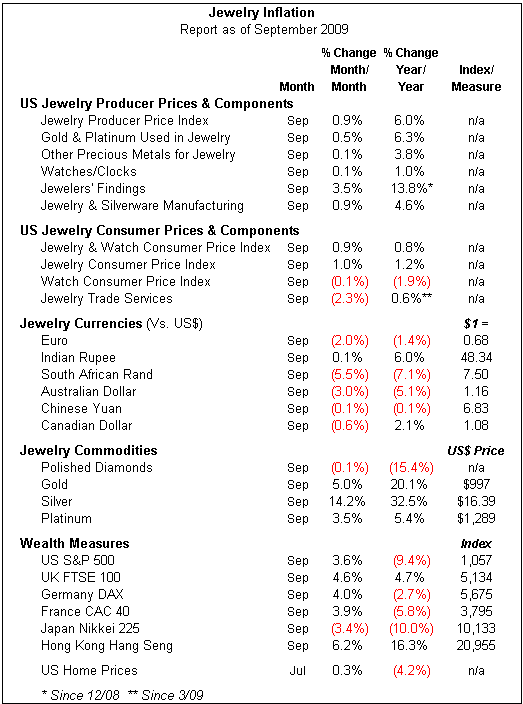
Source: BLS
Broad Inflation Measures Up in Jewelry Industry
Here’s the summary of inflation at the jewelry retail and supplier level for the month of September 2009, as expressed as a percentage change year-over-year (September 2009 versus September 2008) in the U.S. market:
- Jewelry Producer Price Inflation: +6.0 percent
- Jewelry Consumer Price Inflation: +0.8 percent
Earlier this year, it appeared that inflation might be only a distant memory by the end of 2009. Inflation at the retail level for jewelry was steadily declining, and inflation at the producer level was minimal. In mid-year, the Jewelry Producer Price Inflation Index (JPPI) began acting strangely: it spiked in June, but retreated in July, only to rise sharply again in August. The spike in the JPPI in September was dramatic, when compared to producer price inflation earlier this year.
At the retail level, the Jewelry Consumer Price Index (JCPI) has shown a much less volatile trend. However, after a month of deflation in August, it rose in September. One month does not make a trend, but with higher prices at the producer level, consumer jewelry prices are bound to rise eventually.
The graph below illustrates broad inflation trends in the jewelry industry at both the retail level and the producer level for each month of 2009.
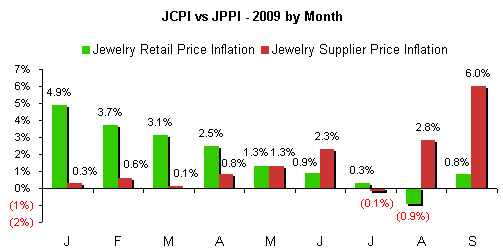
Source: BLS
Jewelry Producer Price Index (JPPI) +6.0 percent In September
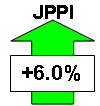 |
The September JPPI inflation rate of +6.0 percent was in line with the average of the Jewelry Producer Price Index for 2008, which averaged +6.3 percent for the full year. Further, the +6.0 percent inflation rate in September is substantially above the annual inflation rate – which averaged about +0.7 percent – that characterized the jewelry producer industry in 2000 through 2002, also a recessionary period. September’s inflation rate was also above the long term Jewelry Producer Price Index increase of about +1.4-1.5 percent annually.
The following graph summarizes the monthly Jewelry Producer Price Index for inflation since mid-2007. The percentage figures are based on year-to-year comparisons of the BLS Jewelry Producer Price Index (September 2009 versus September 2008).
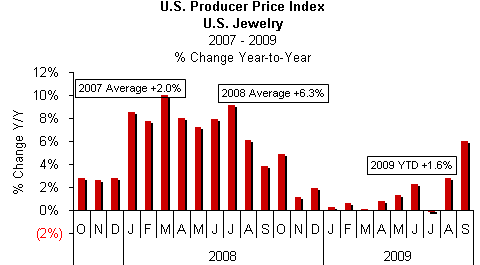 Source: BLS |
Inflation by Commodity up in September vs. Earlier Months
After showing only very modest increases earlier this year, prices for both precious metal jewelry and gemstone jewelry rose in the second quarter, fell back in July, bounced upward in August, and spiked in September. The graph below compares the JPPI (red bars) to inflation for precious metals (gold bars); gold had been the primary driver of precious metals inflation in 2007 and most of 2008. In January 2009, gold prices pulled back modestly, but recently risen sharply. In our opinion, $1,000 gold has been priced into goods produced by jewelry manufacturers. If gold remains higher, as some analysts suggest, that will put further pressure on jewelry suppliers to raise prices.
As the graph below illustrates, prices for precious metals used in jewelry at the supplier (producer) level showed notable inflation, retreated in July, returned in August and spiked in September.
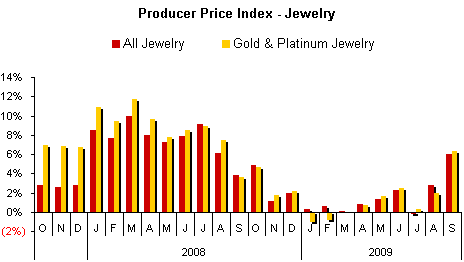 Source: BLS |
Like all producer prices, watch prices heated up in 2008, and remained high through the early spring of 2009. In June, watch price inflation nearly evaporated, and continues to fall. This price index reflects revisions which were made to the Watch Producer Price Index in August. Earlier in the year, watch price inflation appeared to be minimal; it appears that the Bureau of Labor Statistics had an error in its database that has now been corrected.
The following graph summarizes producer price inflation and deflation for watches in the U.S. market.
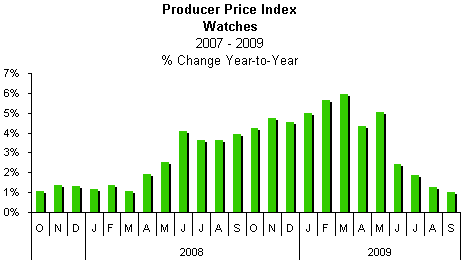
Source: BLS
Jewelry Consumer Price Index (JCPI) +0.8 percent in September
U.S. jewelry consumer prices (JCPI) rose by +0.8 percent in September 2009, as calculated by the BLS. After rising sharply through the second quarter of 2008, jewelry price increases at the retail level moderated in the late summer of last year, a continuing trend due primarily to the current recessionary environment. In August, the JCPI fell into deflationary territory, and it appeared that perhaps retail jewelry prices might be retreating slightly. However, against a background of much higher jewelry producer prices, it is inevitable that retail jewelry prices will rise. 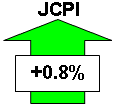
For the full year 2008, retail price inflation for jewelry in the U.S. market ran at an annual rate of +6.9 percent. While the JCPI rose in September, it is not likely to rise sharply enough to rival the level of 2008. We had originally predicted that retail jewelry price inflation might be flat in 2009; this is unlikely. For the seven months year-to-date, retail price inflation for jewelry is +1.8 percent.
The graph below summarizes the percentage change in retail prices of jewelry and watches by month on a year-to-year basis since the beginning of 2008. The percentage change is based on a comparison to the same month a year ago (September 2009 versus September 2008).
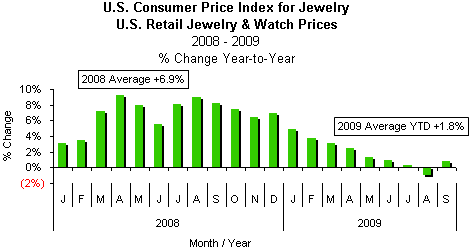
Source: BLS
Watch Prices Show Deflation over Past Three Months
After bouncing around for several months, it became clear in the second quarter of 2009 that watch price inflation at the retail level was moderating. Early in 2008, the components of jewelry and watch price inflation at the retail level reflected a disparity in price increases. Jewelry retail prices were up consistently during the first half of 2008, but watch retail prices showed virtually no price inflation.
Earlier this year, watch price inflation steadily increased at the retail level. In April, watch price inflation slowed dramatically. In May, retail prices of watches inched higher than in April, but the inflation rate was still below earlier months in 2009. In June, watch price inflation diminished significantly. In July, August, and September, watch prices dipped – experienced deflation – in the U.S. market. We expect watch price inflation to track more closely to retail jewelry price inflation over the near term.
The graph below illustrates the JCPI consisting of both jewelry and watch prices (green bars), jewelry prices only (red bars), and watch prices (yellow bars). For the month of September, retail prices of watches declined by 1.9 percent, according to the BLS. This was the same level of decline as in August; in July, watch prices declined by 1.4 percent. In prior months, watch prices rose, though very modestly.
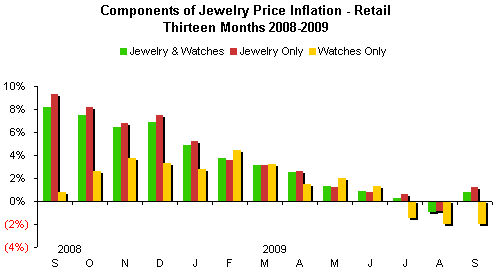
Source: BLS
Outlook: Modest Jewelry Price Inflation in 2009
After rising by nearly 7 percent in 2008, we continue to forecast much more modest jewelry and watch price inflation during 2009. The wild cards, of course, relate to commodity prices, including gold, silver, and platinum. If investors continue to buy these precious metals as hedges against inflation – as historical economic recovery models suggest – it will put upward cost pressure on jewelry suppliers, who will try to pass those price increases along to retailers.
Further, a new wild card has been added to the mix: the value of the U.S. dollar. It has always been lurking in the wings, but it appears to be an active player in today’s market as a determinant of inflation.
While inflation returned to the jewelry industry in September, there are signs that October could see higher inflation, especially if the accelerating decline in the U.S. dollar early in the month, especially against the Euro, triggers a new round of inflation.
Our current prediction calls for 2009 jewelry price inflation to be in the low single digit positive level. The U.S. economy – which accounts for roughly half of all jewelry demand worldwide (by value) – is showing signs that the recession has bottomed. Thus, if consumer demand recovers, we should not experience price deflation; instead, we could experience modest price inflation.